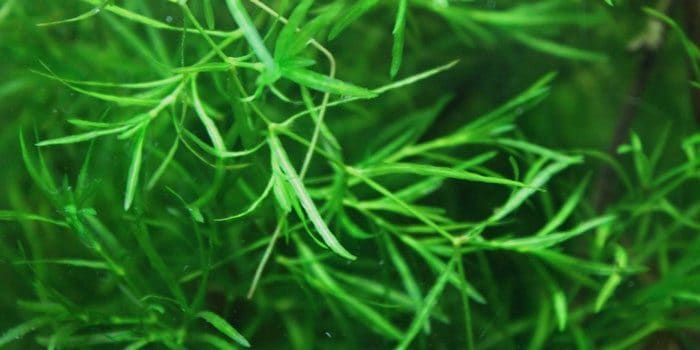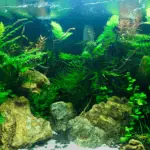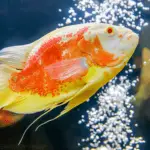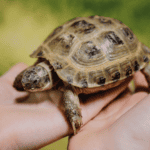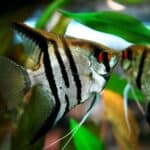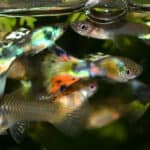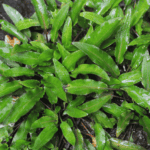Welcome to the world of aquascaping! If you’re here, you’re probably interested in Najas Guadalupensis, also known as guppy grass. Well, you’re in the right place. Let’s dive right into it!
What is Najas Guadalupensis (Guppy Grass)?
Guppy grass, scientifically known as Najas Guadalupensis, is a versatile and fast-growing aquatic plant. Originating from North America, it has become a global favorite for aquatic enthusiasts. This freshwater plant is known for its delicate, feather-like appearance and its bright green color. It’s hardy, adaptable, and an absolute joy to cultivate.
Ideal Conditions for Guppy Grass
Just like all living things, guppy grass thrives under specific conditions. Here’s a quick snapshot:
| Water Temperature | pH Level | Lighting |
|---|---|---|
| 20-28°C (68-82°F) | 6.0 – 7.5 | Moderate |
Beyond this, guppy grass also prefers soft to moderately hard water. It’s a background plant, meaning it tends to grow towards the back of your aquarium, providing a dense thicket of greenery for your tank’s inhabitants.
Benefits of Having Guppy Grass in Your Aquarium
There are numerous reasons why aquarists and hobbyists love guppy grass:
- Habitat for Aquatic Life: It provides an excellent hideout and breeding ground for various species, especially guppies, shrimp, and small fry.
- Water Filtration: Guppy grass helps to absorb excess nutrients, thus preventing harmful algae blooms.
- Ease of Maintenance: It grows quickly and is adaptable to different conditions, making it ideal for beginners.
How to Care for Your Guppy Grass
Caring for your guppy grass is straightforward. Since it’s a fast grower, regular trimming is necessary to prevent it from overtaking your tank. It doesn’t require CO2 supplementation, but like all plants, it will benefit from it.
When it comes to fertilization, a basic aquatic plant fertilizer that contains necessary micronutrients will do the trick. And remember, lighting should be moderate. Too much light can lead to unwanted algae growth.
Propagating Guppy Grass
The propagation of guppy grass is a simple process. Here are the steps:
- Trim a healthy stem from your existing plant.
- Ensure the cutting is at least 5-10 cm long.
- Simply place this cutting in your aquarium where you’d like the new plant to grow.
And that’s it! In a few weeks, you should see the new plant taking root and starting to grow.
Common Issues with Guppy Grass
Despite its hardiness, guppy grass can sometimes experience issues, mainly when its needs aren’t met. Yellowing or browning leaves can indicate a deficiency in nutrients or lighting. If you observe this, consider adjusting your tank’s conditions or introducing a suitable fertilizer.
Choosing the Right Tankmates for Guppy Grass
Guppy grass is incredibly accommodating when it comes to cohabiting with aquatic creatures. Fish like guppies, neon tetras, and mollies get along exceptionally well with this plant. Snails and shrimps such as cherry shrimp or nerite snails are also great options.
Be aware, however, that large or aggressive fish, such as cichlids or goldfish, may damage or uproot the plant. Opting for smaller, peaceful species will help keep your guppy grass safe and your aquatic ecosystem harmonious.
Pairing Guppy Grass with Other Plants
A well-designed aquarium often includes a variety of plant species. Guppy grass works well with other aquatic plants like java fern, java moss, and anubias. These plants have different growth rates and visual characteristics, creating an engaging and diverse aquatic landscape.
Be mindful, though, to not pair guppy grass with light-demanding plants. Since guppy grass can grow dense, it might limit the amount of light reaching your other aquatic plants.
Tips for Maximizing Guppy Grass Growth
To make the most out of your guppy grass, here are a few pro tips:
- Avoid Overcrowding: Ensure the plant has plenty of space to grow. Overcrowding can limit the growth of the plant and negatively impact the overall health of your tank.
- Nutrient Balance: Maintain a balance of nutrients in your tank. An all-in-one liquid fertilizer can be handy to cover all bases.
- Prune Regularly: Regular pruning will keep your guppy grass healthy and prevent it from taking over your aquarium.
Troubleshooting Common Guppy Grass Problems
Even the hardiest of plants can face problems. Let’s discuss a couple of common ones and their solutions:
- Guppy Grass Melting: This is usually due to a sudden change in water parameters. Maintain stability in your water conditions to avoid this.
- Guppy Grass Not Growing: This could indicate a lack of nutrients or inadequate lighting. Check your tank’s conditions and adjust as necessary.
Guppy Grass and Its Impact on Breeding
One unique characteristic of guppy grass is its impact on breeding, especially with livebearers like guppies, mollies, and platies. The dense thicket provided by the guppy grass offers an excellent hiding spot for fry, protecting them from adult fish in the tank.
Additionally, the plant’s surface serves as a place for egg-laying species to deposit their eggs. For breeding enthusiasts, incorporating guppy grass into your aquarium can lead to a thriving population of your favorite fish species.
Conclusion
In a nutshell, Najas Guadalupensis or guppy grass is a fantastic addition to any home aquarium. Its ease of maintenance, fast growth, and the ecological benefits it brings to your aquatic setup make it a win-win choice. Whether you’re a seasoned aquarist or a beginner dipping your toes in the water, guppy grass is an excellent plant to consider for your underwater world.
And remember, every plant has its own rhythm and needs. Take time to understand your guppy grass, provide the right conditions, and watch as it transforms your aquarium into a thriving, green utopia. Happy aquascaping!
Frequently Asked Questions About Najas Guadalupensis (Guppy Grass)
Q1: Is guppy grass easy to grow?
Absolutely! Guppy grass is considered one of the easiest aquatic plants to grow, making it a fantastic choice for beginners. It’s highly adaptable and can thrive in a range of conditions.
Q2: How fast does guppy grass grow?
Guppy grass is known for its rapid growth. Under ideal conditions, it can grow up to 2 inches per week.
Q3: Can guppy grass grow out of water?
While guppy grass is an aquatic plant, it can grow emersed (partially out of water) under the right conditions. However, it thrives best fully submerged in water.
Q4: Why is my guppy grass turning brown?
Browning or yellowing leaves can be a sign of a nutrient deficiency or inadequate lighting. Check the conditions in your aquarium and adjust as needed. You might need to introduce a suitable aquatic plant fertilizer.
Q5: Can I grow guppy grass without a substrate?
Yes, you can. Guppy grass is a floating plant and does not need to be planted in substrate to grow. However, it can also be planted in a nutrient-rich substrate if you want it to stay in one place.
Q6: Does guppy grass need a lot of light?
Guppy grass prefers moderate light levels. Too much light can encourage unwanted algae growth.
Q7: Can guppy grass help in breeding fish?
Indeed, it can. Guppy grass provides a dense and secure hiding spot for fry, which can improve their survival rates. It also acts as an egg-laying site for certain species.
Q8: Can guppy grass live in saltwater?
No, guppy grass is a freshwater plant and will not survive in saltwater conditions.
Q9: How do I propagate guppy grass?
Propagating guppy grass is easy. Simply take a healthy stem, ensuring it’s at least 5-10 cm long, and place it in your aquarium. In a few weeks, it should take root and begin to grow.
Q10: Can guppy grass be harmful to any fish?
Guppy grass is generally safe for most fish. However, keep an eye on larger or more aggressive fish, as they may damage or uproot the plant. It’s best paired with smaller, peaceful species.
